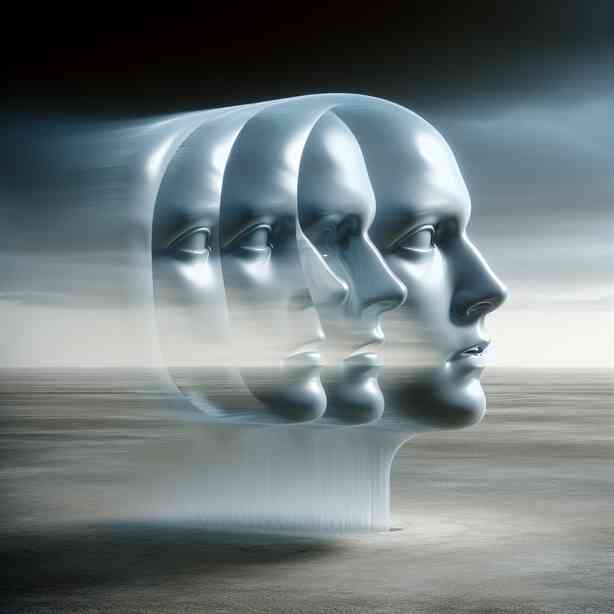
When a face emerges from nowhere, it can evoke a range of emotions, from curiosity to fear. The phenomenon of faces appearing unexpectedly in different environments can be attributed to both psychological and neurological factors. In this exploration, we will delve deep into the science behind this intriguing occurrence, the cultural implications, and the artistic interpretations that have arisen from it.
First, it is essential to understand how our brains are wired to recognize faces. The human brain is particularly adept at identifying patterns, and faces hold a prominent place in this capacity. The fusiform face area, located in the temporal lobe, plays a critical role in facial recognition. Studies have shown that this area becomes activated even when we see patterns that resemble faces, such as those seen in clouds, rock formations, or even abstract art. This phenomenon is known as pareidolia, where our brains attempt to make sense of random stimuli by attributing familiar shapes, in this case, faces.
As we explore pareidolia, it is interesting to note how prevalent this experience is in everyday life. Many people have reported seeing faces in their food, in nature, or on household items. For instance, a simple piece of toast may have a marking that resembles a face, leading to excitement or nostalgia, as people often attribute emotions or personalities to inanimate objects when they perceive them as having human-like features. This anthropomorphism can create a sense of connection, prompting individuals to share their experiences with others.
In various cultures, the concept of seeing faces in unexpected places has been the inspiration for numerous myths and legends. For example, in some indigenous communities, seeing a face in the clouds is viewed as a spiritual sign or a message from ancestors. These interpretations often provide comfort, hope, or guidance to the individuals experiencing them. Thus, the cultural significance of these occurrences transcends mere coincidence, allowing people to weave personal or collective narratives around them.
In the realm of art, the emergence of faces has been a compelling theme for many artists throughout history. Artists like Giuseppe Arcimboldo famously created portraits made entirely of fruits, vegetables, and other objects, emphasizing the idea that faces can be constructed from a myriad of components. Such works often invite viewers to engage in deeper analysis, prompting them to consider not only the artistic technique but also the inherent symbolism behind the human visage. The melding of form and content in art can mirror the merging of reality and perception that occurs when we see faces emerging from nowhere.
Psychologically, the experience of encountering unexpected faces can stir strong feelings. For some, these occurrences might trigger a sense of comfort and familiarity, while for others, they may evoke feelings of unease or even fear. This dichotomy can be attributed to individual differences in personality, past experiences, and emotional states. The sense of a “watchful eye” can transform benign moments into sources of anxiety, particularly in contexts where individuals feel vulnerable or alone.
Moreover, in contemporary discussions regarding artificial intelligence and deepfakes, the idea of faces emerging from nowhere takes on an additional dimension. As technology advances, the ability to create hyper-realistic images, including fake faces, has become increasingly feasible. This raises ethical questions surrounding authenticity, identity, and representation in our digital age. The line between reality and fabrication blurs, complicating the way we perceive both real faces and their fabricated counterparts.
The implications of these developments extend to societal concerns, particularly in the realms of media and communication. As people come to terms with the proliferation of altered images and videos, the trust in facial recognition diminishes. Authentic connections, which were once predicated on the simple act of seeing and recognizing a familiar face, are challenged by the pervasive presence of deceitful digital representations. Hence, understanding the intricate relationship between genuine and artificial faces becomes paramount in navigating modern interactions.
In the context of mental health, the frequent occurrence of seeing faces in everyday objects can serve as an avenue for exploration and understanding emotional states. Therapists may use this phenomenon as a way to engage clients in conversations about their feelings and experiences. People might find meaning in the faces they see, reflecting their current emotional landscape or unresolved conflicts. By utilizing pareidolia as a therapeutic tool, individuals can address underlying issues while fostering deeper self-awareness.
Ultimately, the emergence of a face from nowhere serves as a reminder of the profound connection between perception, emotion, and the human experience. It encompasses not only psychological and neurological explanations but also cultural narratives, artistic expressions, and technological implications. The seemingly simplistic act of recognizing a face can unveil a tapestry of meanings, resonating with our innate desire to find connection and understanding amid the chaos of our surroundings.
As we reflect on these ideas, we can appreciate the multifaceted layers that come into play when a face unexpectedly appears. Whether seen in a moment of solitude or captured in a fleeting glance, the significance of these experiences can profoundly shape our understanding of ourselves and the world around us. This interplay between reality, perception, and interpretation invites us to embrace the richness of the human experience, encouraging us to seek out the stories behind the faces we see, whether they are real or imagined.
In conclusion, the phenomenon of seeing faces emerge from nowhere brings forth an intricate blend of science, culture, art, and personal experience. By examining these elements, we gather insights not only into our cognitive processes but also into the ways we construct meaning within our lives. As we journey through our environments, let us remain attuned to the magic that can arise when we unexpectedly encounter a familiar face, for these moments often open doors to deeper reflections and a greater appreciation of our shared humanity.


